Affiliate disclosure: This post may contain affiliate links. Please see our Privacy Policy.
Companion planting strawberries ensures that you get the most out of your garden space, while at the same time helping your berry plants succeed.
While they’re often companion planted with herbs and flowers to either discourage pests or encourage pollination, why not companion plant your strawberries with mushrooms for better soil and higher yields?
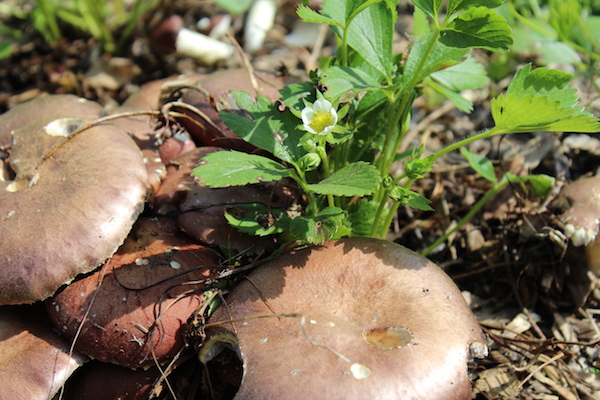
Wine cap mushrooms (Stropharia rugosa-annulata) are well known for their ability to build soil, and we can use all the help we can get supplementing our incredibly shallow soils. Our land has 6 to 18 inches of topsoil on top of an impenetrable layer of clay, which makes gardening difficult in most areas. We’ve put a lot of work into building soil and naturally raised beds with hugelkultur, but woody debris takes time to break down into fertile soil.
Strawberries are shallow-rooted, so they don’t mind thin topsoils, but they’re heavy feeders. Without enough nutrients, they won’t bear good crops. That’s where mushrooms come in!
Mushrooms, namely wine caps, break down woody substrates and convert them to fertile soil rich with organic matter. They also improve water holding capacity, which helps buffer the berries on hot summer days.
Wine cap mushrooms are generally inoculated in a bed of straw or wood chips spread on top of soil. Since that’s how strawberries are mulched, it seems only natural to innoculate the strawberry mulch with wine cap mushroom spawn for better soil and a double harvest.
While the mulch may only be on the top few inches of the soil, wine cap mushroom mycelium will reach deeper, pulling up moisture and nutrients from below the strawberries’ root line. Midway through the season, a shovel is all you need to see the mycelium running…
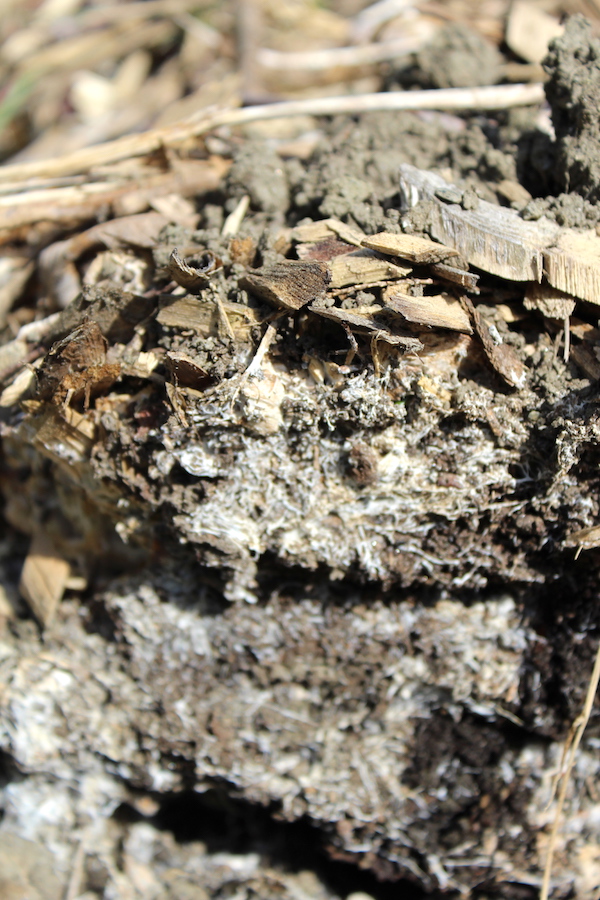
How to Grow Wine Cap Mushrooms with Strawberries
Many gardeners already know the basics of growing strawberries, but mushrooms are not just a whole new crop, they’re a whole new kingdom, far different than anything they’ve ever grown.
No worries! Wine caps are absurdly easy to grow, incredibly forgiving, and believe it or not, they may already be thriving in your yard.
All wine caps need to grow is ample carbon substrate, such as straw or wood chips, and consistent moisture. Nothing too wet, just about the same amount of water you’d otherwise use to keep your strawberry plants healthy.
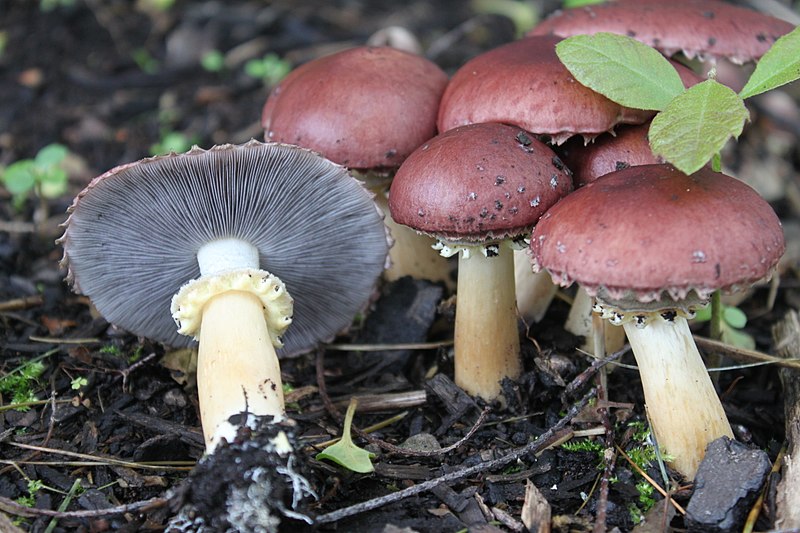
While most mushrooms want shade or semi-dark conditions to grow, wine caps don’t mind growing in full sun as a strawberry companion plant. In full sun, the color of the caps will wash out a bit to more of a dull brown, but the mushrooms are tasty just the same.
Start by mulching your strawberries as you normally would, with a thin layer of straw or wood chips. Spread on a layer of sawdust inoculated with wine cap mushroom mycelium (wine cap mushroom spawn).
They generally say one 5 pound bag of wine cap mushroom spawn is enough for 50 square feet, but as a side crop along with strawberries, we’ve been successful at much lower inoculation rates (5lbs to 100 or 200 square feet).
After sprinkling on the mushroom spawn, add on another inch or so of mulch and then water the whole patch thoroughly. At this point, your wine cap mushrooms are “planted” and they’ll keep producing right alongside the perennial strawberry plants for years, assuming you keep feeding them by mulching the strawberry plants each year.
Once a patch is going strong, you can harvest a handful of strawberry mulch and transplant the mycelium to a new location to expand your mushroom patch.
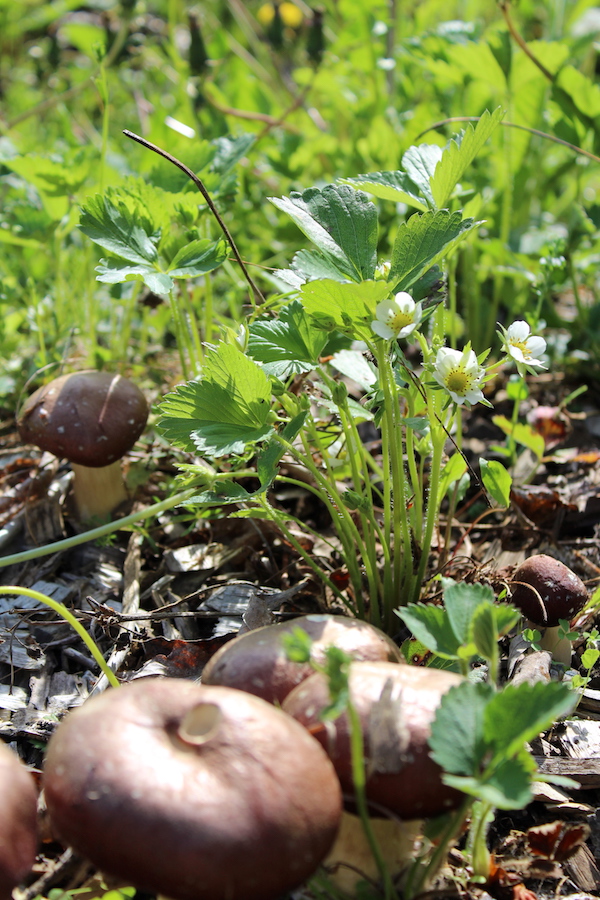
Harvesting Wine Cap Mushrooms
When harvesting any mushroom, cultivated or otherwise, be sure you know how to identify it with complete certainty. Wine caps are pretty safe for beginning mushroom identifiers, but just be aware that other mushroom spores could also be in the patch, and just because it’s a mushroom in your patch doesn’t mean it’s a mushroom you planted.
Wine cap mushrooms need to be harvested promptly, early in the morning each day. They are favorites of garden insects, and by midday, believe it or not, they’re often half bug-eaten. Harvest them by gently breaking them off at the soil line, they should come away easily.
Once harvested, wine cap mushrooms don’t keep well, and that’s one reason you’ll never see them in the supermarket. Use, dehydrate or freeze them within 1-2 days for best results.
We mostly grow everbearing strawberries, which bear early in the spring, take a break during the heat of high summer and then bear heavily again in late summer and early fall as temperatures cool off. Wine cap mushrooms follow a similar pattern, which means you’ll be harvesting both at the same time during the cooler parts of the growing season.
Be sure to keep both crops well-watered during the hot, dry period many places experience in the heat of the summer growing season.
Other Strawberry Companion Planting Options
- Strawberries & Asparagus – This coming year, I’m excited to try companion planting strawberries with asparagus. Both crops benefit from straw mulch, and while strawberry roots stay very shallow, asparagus roots only occupy soil space at 10+ inches deep. That means they can grow together without much competition, effectively doubling yields from a small space. We grow asparagus from seeds (rather than crowns), so it’s easy to get a huge patch started for just a small investment.
- Strawberries & Chives – Chives help to deter pests around strawberries, but they also act as a cut and grow again fertilizer. Herbs like chives accumulate micronutrients in their leaves, and if you cut the chives to mulch the strawberries, the decomposing chive shoots make those nutrients available to shallow-rooted strawberries.
More Companion Planting Resources
- Companion Planting Chart from the Permaculture Research Institute
- Carrots Love Tomatoes: Secrets of Companion Planting for Successful Gardening
More Strawberry Goodness
- Canning Strawberries
- Low Sugar Strawberry Jam
- Sugar-Free Strawberry Jam
- 30+ Ways Can Strawberries (Jam, jelly, syrup and more)
- Strawberry Wine
- Transplanting Strawberries
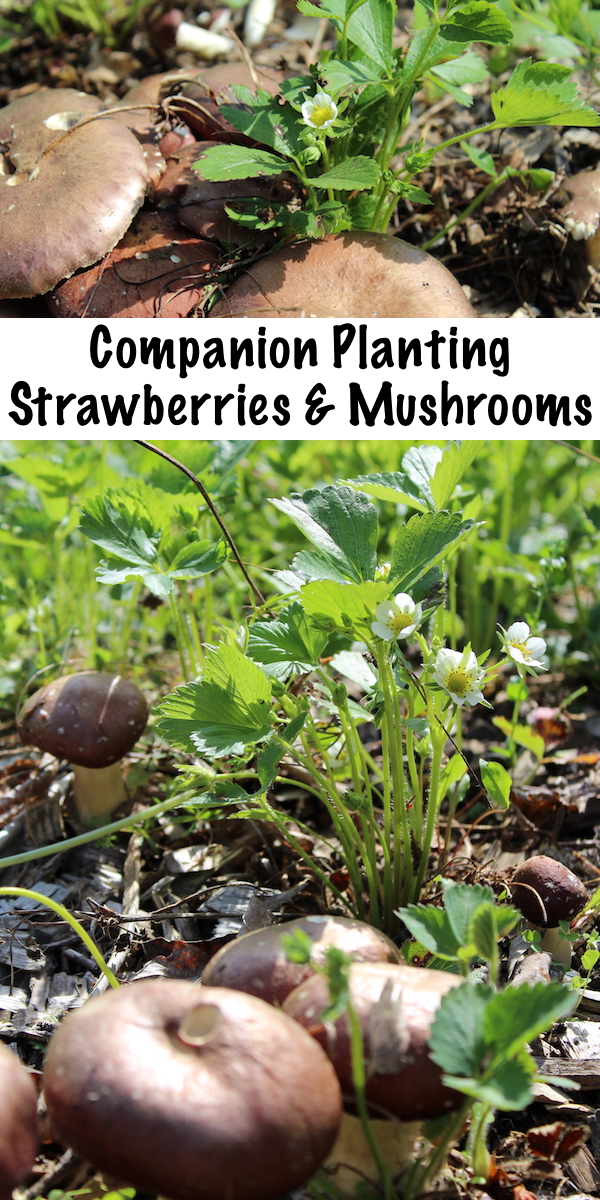
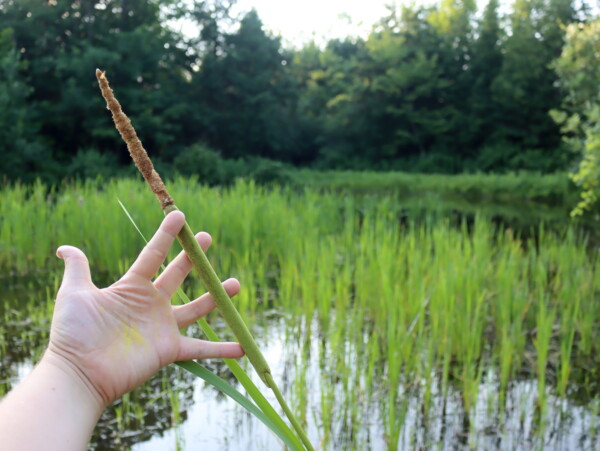
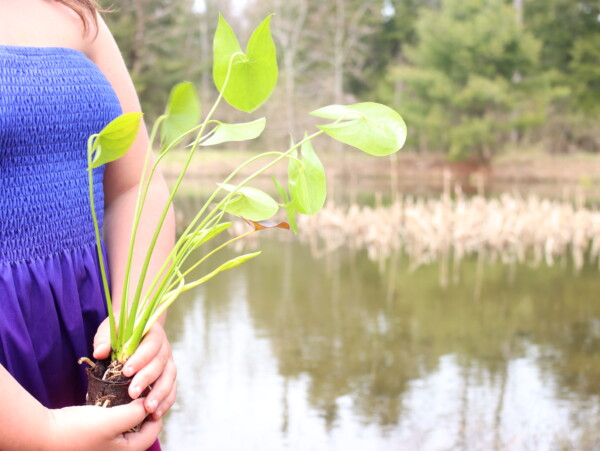
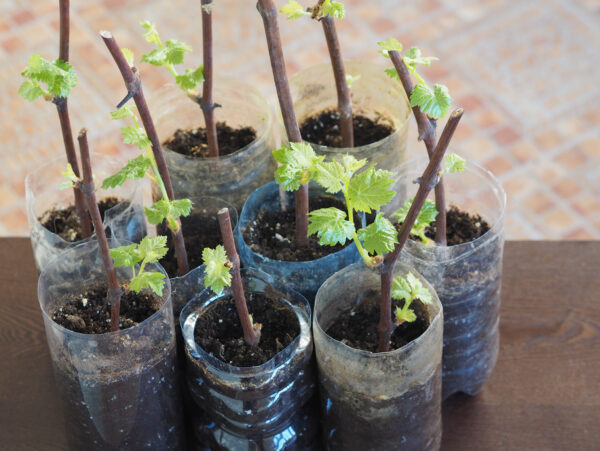
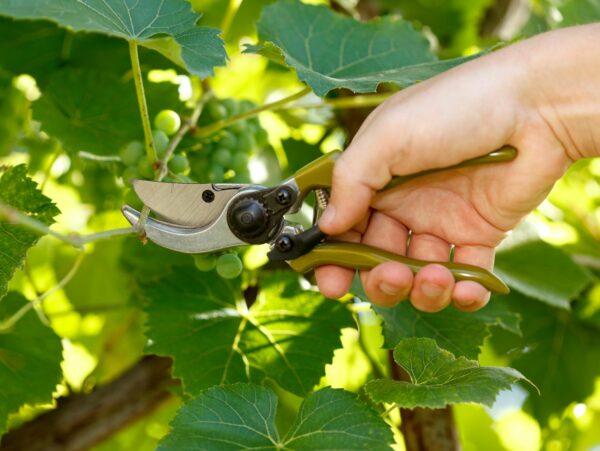
Hi, Ashley
We’re planting wine caps and oyster mushrooms in our straw mulch this year. We’ve tried log plugs in the past but this is our first time just tossing them into the vegetable garden with the other plants. I’m intrigued and excited to see how this works.
Thanks for your post. I wasn’t planning on adding it to my strawberry bed but now I’m definitely going to add this to my list.
Also, thanks for linking to Joybilee Farm’s post on companion planting strawberries and asparagus. That garden bed with asparagus is still going strong. The strawberries are the kind that runner and they keep filling in the spaces so the bred continues to be fruitful, even after many years.
That’s wonderful Chris! I can’t wait to find out how it works out for you.
Will Sunflower and wine cap grow well together? I’m also experimenting with a raised bed hugelkultr wing cap inoculated .
Sounds like a good combination to me!
Any chance we can combine all 3 — strawberries, asparagus, and winecaps?
No reason why not. The main reason that I haven’t added asparagus is because they want different soil pH than strawberries in an ideal world, but honestly, I’m not sure how much that matters. I’m currently growing winecaps, strawberries, and garlic together this year simply because I ran out of space in the garlic bed. I’m hoping that the garlic helps keep pests away from the strawberries, but we’ll see.
Does that deter snails?
Nope. Both the mushrooms and the strawberries are delicious to snails.
Where do I get the winecap spore sawdust?
This is where we get ours: https://www.fieldforest.net/category/wine-cap-mushroom-spawn
Thank you for sharing the steps on how to grow our very own mushrooms. Bringing this alternative medicine closer and accessible to people who really need it. I hope that people will start to realize that cure is always within our reach, it can even be in our own backyard.
We are planting a large raised bed garden this year. We are excited to find what grows well with strawberries as they are delicate. I dont know whether to try mushrooms, asparagus or chives. Maybe I will try all three and post what works best.